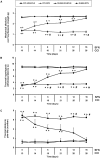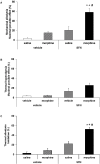Sulforaphane Inhibited the Nociceptive Responses, Anxiety- and Depressive-Like Behaviors Associated With Neuropathic Pain and Improved the Anti-allodynic Effects of Morphine in Mice
- PMID: 30542282
- PMCID: PMC6277937
- DOI: 10.3389/fphar.2018.01332
Sulforaphane Inhibited the Nociceptive Responses, Anxiety- and Depressive-Like Behaviors Associated With Neuropathic Pain and Improved the Anti-allodynic Effects of Morphine in Mice
Abstract
Chronic neuropathic pain is associated with anxiety- and depressive-like disorders. Its treatment remains a serious clinical problem due to the lack of efficacy of the available therapeutic modalities. We investigated if the activation of the transcription factor Nrf2 could modulate the nociceptive and emotional disorders associated with persistent neuropathic pain and potentiated the analgesic activity of morphine. The possible mechanisms implicated in these effects have been also evaluated. Therefore, in C57BL/6 mice with neuropathic pain induced by the chronic constriction of the sciatic nerve (CCI), we assessed the antinociceptive, anxiolytic, and anti-depressant effects of the repeated intraperitoneal administration of a Nrf2 inducer, sulforaphane (SFN), and the effects of this treatment on the local antinociceptive actions of morphine. The protein levels of Nrf2, heme oxygenase 1 (HO-1), NAD(P)H:quinone oxidoreductase-1 (NQO1), CD11b/c (a microglial activator marker), mitogen-activated protein kinases (MAPK) and μ opioid receptors (MOR) in the spinal cord, prefrontal cortex and hippocampus from mice, at 28 days after CCI, were also evaluated. Our results showed that the repeated administration of SFN besides inhibiting nociceptive responses induced by sciatic nerve injury also diminished the anxiety- and depressive-like behaviors associated with persistent neuropathic pain. Moreover, SFN treatment normalized oxidative stress by inducing Nrf2/HO-1 signaling, reduced microglial activation and JNK, ERK1/2, p-38 phosphorylation induced by sciatic nerve injury in the spinal cord and/or hippocampus and prefrontal cortex. Interestingly, treatment with SFN also potentiated the antiallodynic effects of morphine in sciatic nerve-injured mice by regularizing the down regulation of MOR in the spinal cord and/or hippocampus. This study suggested that treatment with SFN might be an interesting approach for the management of persistent neuropathic pain and comorbidities associated as well as to improve the analgesic actions of morphine.
Keywords: Nrf2 transcription factor; analgesia; anxiety; chronic pain; depression; opioids; oxidative stress.
Figures







Similar articles
-
Treatment With the Delta Opioid Agonist UFP-512 Alleviates Chronic Inflammatory and Neuropathic Pain: Mechanisms Implicated.Front Pharmacol. 2019 Mar 26;10:283. doi: 10.3389/fphar.2019.00283. eCollection 2019. Front Pharmacol. 2019. PMID: 30971925 Free PMC article.
-
Treatment with 5-fluoro-2-oxindole Increases the Antinociceptive Effects of Morphine and Inhibits Neuropathic Pain.Cell Mol Neurobiol. 2021 Jul;41(5):995-1008. doi: 10.1007/s10571-020-00952-w. Epub 2020 Sep 2. Cell Mol Neurobiol. 2021. PMID: 32880099 Free PMC article.
-
Mechanism implicated in the anti-allodynic and anti-hyperalgesic effects induced by the activation of heme oxygenase 1/carbon monoxide signaling pathway in the central nervous system of mice with neuropathic pain.Biochem Pharmacol. 2018 Feb;148:52-63. doi: 10.1016/j.bcp.2017.12.007. Epub 2017 Dec 13. Biochem Pharmacol. 2018. PMID: 29247614
-
The role of carbon monoxide, heme oxygenase 1, and the Nrf2 transcription factor in the modulation of chronic pain and their interactions with opioids and cannabinoids.Med Res Rev. 2021 Jan;41(1):136-155. doi: 10.1002/med.21726. Epub 2020 Aug 20. Med Res Rev. 2021. PMID: 32820550 Review.
-
The plasticity of the association between mu-opioid receptor and glutamate ionotropic receptor N in opioid analgesic tolerance and neuropathic pain.Eur J Pharmacol. 2013 Sep 15;716(1-3):94-105. doi: 10.1016/j.ejphar.2013.01.066. Epub 2013 Mar 13. Eur J Pharmacol. 2013. PMID: 23499699 Review.
Cited by
-
The role of isothiocyanate-rich plants and supplements in neuropsychiatric disorders: a review and update.Front Nutr. 2024 Sep 30;11:1448130. doi: 10.3389/fnut.2024.1448130. eCollection 2024. Front Nutr. 2024. PMID: 39421616 Free PMC article. Review.
-
The Anxiolytic and Antidepressant Effects of Diallyl Disulfide and GYY4137 in Animals with Chronic Neuropathic Pain.Antioxidants (Basel). 2021 Jul 3;10(7):1074. doi: 10.3390/antiox10071074. Antioxidants (Basel). 2021. PMID: 34356307 Free PMC article.
-
The Antinociceptive, Antioxidant and Anti-Inflammatory Effects of 5-Fluoro-2-Oxindole during Inflammatory Pain.Antioxidants (Basel). 2020 Dec 9;9(12):1249. doi: 10.3390/antiox9121249. Antioxidants (Basel). 2020. PMID: 33316895 Free PMC article.
-
The role of antioxidant therapy in modulating neuropathic pain: A systematic review of mechanistic insights and research trends (2003-2024).Brain Circ. 2025 Apr 16;11(2):113-126. doi: 10.4103/bc.bc_72_24. eCollection 2025 Apr-Jun. Brain Circ. 2025. PMID: 40520069 Free PMC article. Review.
-
Advances in Neuropathic Pain Research: Selected Intracellular Factors as Potential Targets for Multidirectional Analgesics.Pharmaceuticals (Basel). 2023 Nov 17;16(11):1624. doi: 10.3390/ph16111624. Pharmaceuticals (Basel). 2023. PMID: 38004489 Free PMC article. Review.
References
-
- Alba-Delgado C., Cebada-Aleu A., Mico J. A., Berrocoso E. (2016). Comorbid anxiety-like behavior and locus coeruleus impairment in diabetic peripheral neuropathy: a comparative study with the chronic constriction injury model. Prog. Neuropsychopharmacol. Biol. Psychiatry 71 45–56. 10.1016/j.pnpbp.2016.06.007 - DOI - PubMed
-
- Bennett G. J., Xie Y. K. (1988). A peripheral mononeuropathy in rat that produces disorders of pain sensation like those seen in man. Pain 33 87–107. - PubMed
LinkOut - more resources
Full Text Sources
Research Materials
Miscellaneous

